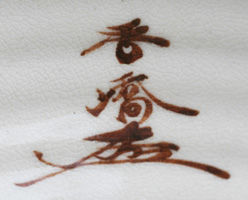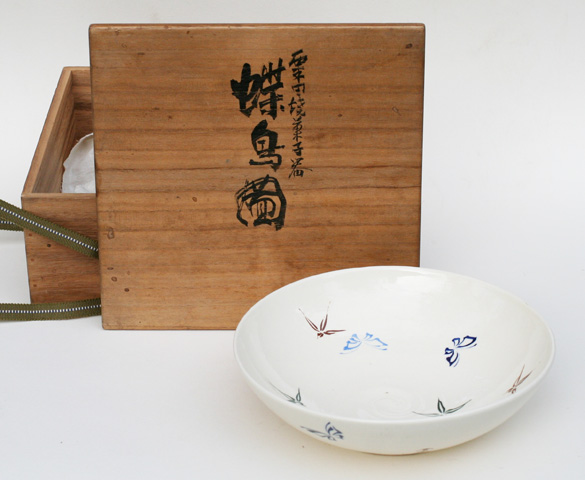Nihonga, Awatayaki
Kashiki, cake bowl - Chôchô, ButterfliesSigned: Kôkyô
Seals: Kaô
Technique: Awatayaki cream glazed earthenware with white, green and two shades of blue underglaze decorations of butterflies and green and red leaves. Ø 21,5 x 6,1
Box: authenticated by his pupil: Ikai Shôkoku (1881-1939)
Condition: fine
With Takeuchi Seihô, Tsuji Kakô and Kikuchi Hôbun, Taniguchi Kôkyô was one of the four outstanding pupils of Kônô Bairei and with them one of the founders of the modern Kyoto School. He taught at the Kyoto Municipal School of Fine Arts and Crafts and at the Kyoto college of Fine Arts. He exhibited at the Bunten and at the Paris World’s Fair. He was specialized in depicting historical subjects. Suffering from illness since the 1890s cut short his career.
Reference:
Roberts p. 174
Araki p. 1406
Aburai p. 246
Berry & Morioka ‘99 p. 102-105 (# 15)
The Awataguchi (Awata kiln) is one of the eldest kilns active in Kyoto.
This type of Kyoyaki is said to have come from Seto, Aichi prefecture by Sanmonjiya Kyuuemon who started the first kiln. Not surprising that the early Awatayaki glaze is similar to Setoyaki glaze. Many famous potters worked in Awata and introduced their techniques. And from where Nonomura Ninsei (c.1574-1660/6) introduced the bright colours into Kyoyaki. Before Dôhachi Nin’ami (1783-1855) opened his kilns near Gojô he worked in Awata. Mokubei (1767-1833) had his kiln there and also Rengetsu (1791-1875) produced some of her pottery in its kilns.
Price: ON REQUEST

